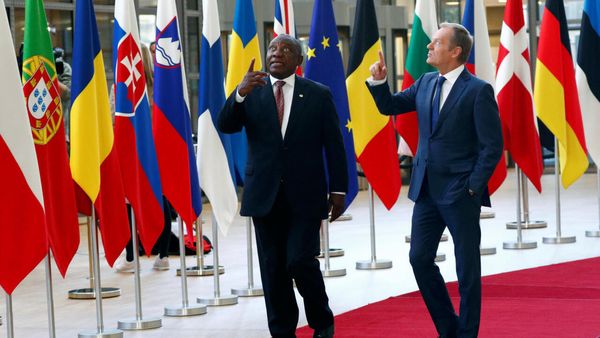A perfectly hit serve might be the most enjoyable action in sport.
The loud thump of a ball rocketing off the racquet, the sight of a ball sliding off the paint in the corner of the service box.
There is also the dejected returner, walking away knowing there was nothing they could do.
A perfectly hit serve grabs the attention, just like a well-timed cover drive in cricket or a powerful slam dunk in basketball.
More than any other shot in tennis, the serve shapes games, matches and careers. The serve dictates the way a point is played, its shape and structure.
Serves come in all shapes and sizes. They are almost like snowflakes, as they are unique to each player.
Some go for the slice, others the kick or the flat serve. Some players have a subtle, compact motion, and some are more expressive, looking more like a spring being set free.
So what happens when it disappears?
It's a question that women's world number two Aryna Sabalenka is rapidly trying to come to grips with.
For most of the 2021 season, Sabalenka's rise up the rankings was driven by her ability to dominate points with her big, right-handed serve. She is one of the most talented players in the game and the youngest player inside the women's top five.
At Wimbledon last year, the speed of Sabalenka's average first serve was nearly as fast as that of Roger Federer, with her ability to generate pace off the start of points right at the top end of the women's game.
Sabalenka plays a notably aggressive form of tennis, a risk-reward brand that is compelling to watch. The young Belarusian is unafraid to throw caution to the wind, and her massive number of winners is often accompanied by a large number of unforced errors.
But in her most recent match — in Adelaide against world number 93 Rebecca Peterson — a series of worrying signs came to the fore.
In the first set, Sabalenka sent down 11 double faults, and in the second another seven. By the third set, she had resorted to sending down underarm forehands, just to get the ball in play.
It wasn't enough, and Peterson recorded her first win against a top five-ranked opponent. For Sabalenka, it was her fourth loss in a row and sixth in her last eight matches.
The major weapon of the second best player in the world had deserted her, on the cusp of one of the biggest tournaments of the year.
What happened, and can she find her groove again in time?
Serve goes missing
Last year's US Open was a momentous one for women's tennis.
The final saw two unseeded teenagers face off for the title with the champion, Emma Raducanu, the first qualifier to win a major singles title in the open era. In an unpredictable year for sport in general, it was one of the more unpredictable outcomes.
But coming into the semi-finals, most thought it was Sabalenka's title to lose. With an early tournament wrist injury behind her, her form was strong.
Sabalenka's semi-final against unseeded 19-year-old Canadian Leylah Fernandez was tight. In the first set tie-break, a double fault handed the decisive edge and eventually the set to Fernandez.
The third set was shaping to be a classic after Sabalenka squared the match in the second. The first nine games of the set followed the form, with gruelling battles on serve and the match on a knife edge.
But then Sabalenka's serve failed.
In the final game, Sabalenka double faulted twice and missed another first serve to boot. Instead of sending the match to a tie-break, Sabalenka lost the set and the match on serve.
After the match, Sabalenka was blunt in her assessment.
"In a couple of — I would say key moments — my serve didn't work well," Sabalenka said.
"I'm really disappointed with that."
When asked what Fernandez did to turn around the match in the third set, Sabalenka was equally clear.
"I wouldn't say that she did something. I would say that I destroyed myself," she replied.
Since then, Sabalenka's serving issues have only gotten worse.
At the season-ending WTA Tour Finals in Guadalajara, Sabalenka entered the eight-player field as the top seed, but was knocked out in the group stage with just one win to her name.
For the tournament, more than 15 per cent of her service points ended in double faults, nearly twice her lifetime average.
After her final loss in Guadalajara, Sabalenka was asked what went wrong.
"[I'm] So really disappointed with my level in the end of the season and with my serve," she said.
"I guess I will work a lot on my serve in the preseason."
When prompted about whether the issues were injury related, she was sanguine.
"I just couldn't find my rhythm," Sabalenka said.
"The whole match I was really struggling with my serve. On some moment I found it, and on some moment I couldn't do anything with my serve."
Nearly overnight, one of her biggest strengths has turned into her biggest weakness.
And things haven't gotten better in 2022.
The yips, or something bigger?
Sabalenka is far from the first player to struggle with their serve on the big stage.
In a sport where so much of the mental overlaps with the physical, getting everything working together is sometimes tough.
For some players, the issue is more physical than mental, restricted by a body worn down by the year-long grind of the professional tennis tour.
Shortening the service motion or going to a secondary serve — such as using a slice serve — can get a player into a match.
Quite famously, Michael Chang initially served underarm while suffering from exhaustion on the way to his 1989 French Open win, before utilising the tactic as a weapon due to its early success.
For others, the issue appears to be more mental, or seemingly a case of the 'yips'.
The phenomenon is hard to quantify, but easy to recognise. Many theories abound as to what causes it.
It often presents as a lack of control over what the body is doing. It's also not exclusive to tennis, with professional golfers and cricketers suffering among others.
Broadly speaking, the yips are involuntary movements that happen in skilled motor behaviours — think hitting a golf ball or bowling a ball in cricket. Often it's a jerk of the arm or a freeze in a normally fluid movement.
Some scientists have theorised that it is related to damaged nerves, while other researchers have suggested that it is worse for players that focus and try to correct the problems as they occur.
As the focus increases and corrections are made, anxiety can rise and the problems can intensify.
In recent years, top-level players such as Alexander Zverev and Sara Errani have struggled with the phenomenon at major tournaments.
For some, the problem resolves after mere days or weeks. For others, such as Errani, the issue tracks them for years.
For Sabalenka, the cause is a little hard to unwrap. The issues seem to have significantly worsened after she fell on her wrist at the 2021 US Open, and her subsequent battle against COVID-19.
But repeatedly in interviews she has suggested the problem is more mental, and an issue with her contact on the ball.
With a high ball toss and using heavy service motion, the room for error in her serve is high. Even when she has tried to simplify her motion, the results haven't followed.
According to Jeff Sackmann's Match Charting project, Sabalenka serves the ball wider than almost every other female player. A wide service gives players more room to get the ball in the service box.
For Sabalenka, that extra room hasn't been enough as she has struggled to find the rhythm of her service motion.
The fortnight ahead
Despite her recent struggles, Sabalenka still heads into the Australian Open as the second seed behind Australia's Ash Barty and is feared by many in the draw.
Up first in her journey to the title is Australian veteran Storm Sanders, who is looking for her first singles win at a major at the age of 27.
For Sanders, it's potentially an opportunity of a lifetime. Sanders is also playing doubles at the Open with Barty, with her involvement in the tournament expected to go into the second week.
Sabalenka remains one of the most impressive young players in the game. Women's tennis is in a particularly competitive place at the moment, with a number of challengers for Barty's number-one ranking.
If she can find her serve again, Sabalenka is at the head of the chasing pack. But that's a big if, especially on the eve of one of the biggest tournaments of the year.







